|



| |
Jerry Korb
a.k.a. The Mellotron Professor
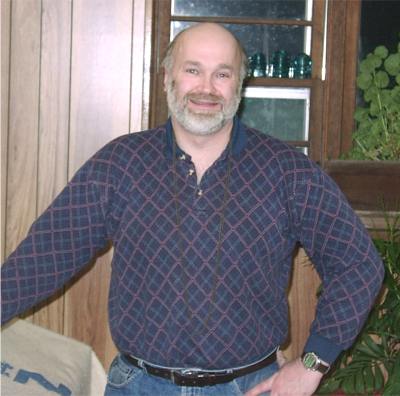 |
Jerry "Mellotron Professor" Korb lives with his wife Mali in
the woods of northern Vermont, not far from Smuggler's Notch or Essex, kinda
in between Montpelier and Burlington if you went out of your way a little. The
Korb residence is a ranch-style
house set on the height of land on 7+ acres. Accessible
only by a dirt road, you can't see any other house from his, although there
are some nearby. Out the back door is a view of a nearby hill (great
in the fall when the trees change color), and out the front door is a view of Mt. Mansfield when the
leaves are down. Jerry spends some of his time chopping wood for the
wood stove, which helps heat his place during the colder months. On
the sunny days it's nice to sit out on the back porch or take a walk down
the road. At night the stars are plentiful. This ain't no city
living, and in my book it can't be beat. |
For several years Jerry was employed by Leica as a contractor to IBM in
Essex, VT, involved with the manufacturing of computer chips---engineering,
logistics, manufacturing, machine upkeep, you name it.
As you've seen elsewhere on this site, Mellotrons are Jerry's game.
He bought his M400 new back in the mid 70s when he played in a band that
did some Moody Blues and Genesis covers. Since then he created the JK-MK6
from two Mellotron M400 machines, rebuilt an M300 that was dropped, and most
recently restored
"Julia", a Mark I. In the fall of 2003 Jerry brought back to
working condition a Mark II purchased by "The Mellotron Book" author Frank
Samagaio.
Jerry is also available to work on or restore your Mellotron, too.
Please drop me a note, and I will put him in touch with you.
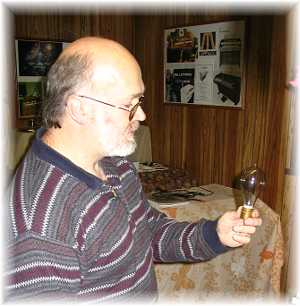 |
But...it doesn't stop there. Jerry is also a collector of Edison
memorabilia and has a vast array of light bulbs of all types. A
few years ago he also began collecting telephone/telegraph pole insulators.
And Jerry is heavily involved in researching and preserving the Morris Canal
in NJ...and he recently became interested in the local railroads.
What's next? Who knows! |
LET THERE BE LIGHT
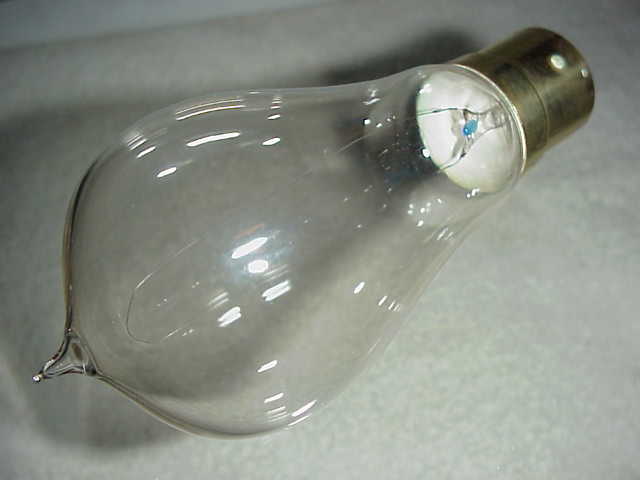 |
Jerry has collected historic light bulbs for over 30 yrs. He now has a
museum-size collection of the earliest Edison bulbs to the largest/newest items.
His bulbs appeared in many places, from news-articles to TIME-LIFE™ Books.
Jerry's one of a select group of vintage lighting historians, recognized by
many firms and organizations, who often forward inquiries to him
from individuals. He recently participated in appraising the world's
largest collection (60,000 bulbs) in Baltimore.LEFT:
Hand-made bulb from 1885, Lynn, Massachusetts. Bamboo filament,
non-standard base |
|
 |
Early tungsten filament, circa 1910. It's
the size of a football, and it's a bright 250 watts. This bulb was
discontinued in 1916. (Click on the thumbnails to the left for larger
pictures.) |
|
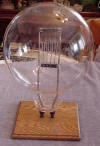
 |
Another tungsten filament, this time from around
1950 in a studio spotlight. Glowing at a mere 10,000 watts, this would
make your electric meter spin out of control, drawing 83 amps at 120 volts. |
THE GLASS ART OF INSULATORS
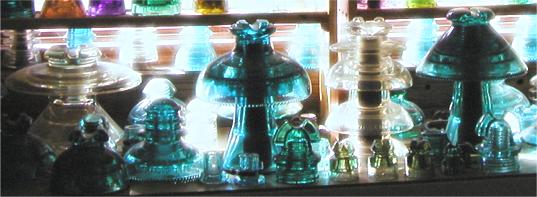 |
|
 |
For decades telephone and telegraph poles were adorned with the most
unassuming glass insulators. People took them for granted, something
that would always be there, so they gave them little thought. Many
were made, but, as it turns out, precious few were preserved, most just
tossed aside as junk. These gems have been replaced by drab, common
insulators on top of today's power poles.

Have a look at this scene above Jerry's front door (click the thumbnail
above). Each insulator
is a small piece of art, and it glimmers as it catches the daylight.
There are big ones that look like giant mushrooms, some that look like the
headgear warn by the Gallifrey leaders on Dr. Who, some that look
like they'd be at home on a rowboat holding an oar, and some that look like
spaceships. All different colors, too. If you look carefully, you
will see the threads running through the middle of these gems. The
insulators were screwed onto threaded sticks and perched atop the telephone
poles, much like you'd screw a broom handle in. |
|
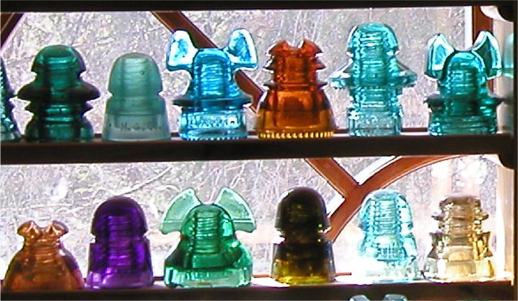 |
THE MORRIS CANAL PROJECT
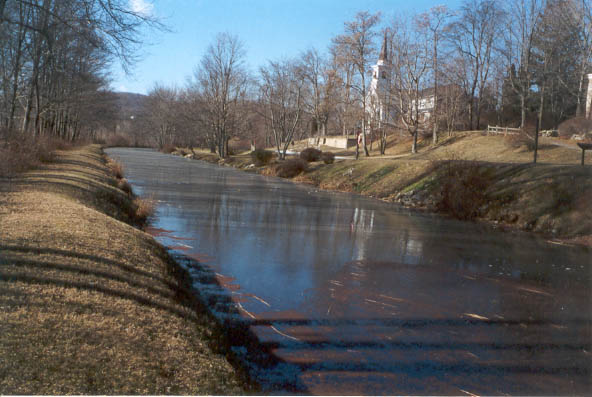 |
Jerry has taken his passion for things yesteryear to the
hills of NJ to research the unique Morris Canal (1824-1924). It was the
highest climbing canal ever built, overcoming 1674' elevation change over
102 miles. The Morris Canal used 23 inclined-planes to raise/lower boats up
to elevations of 100' (the only canal in the US to do so) and had 34
conventional locks. Jerry spent his early years on the shores of Lake
Hopatcong (Lenape name), which also was used to supply the Morris Canal with
water, and later became a summer resort. LEFT:
Morris Canal restored at historic Waterloo Village, New Jersey |
 |
Photo taken in late 2000 at the eastern end of the
Morris Canal at Liberty State Park. Note the World Trade Center towers
in the background. |
 |
Perry's Store is located in Port Murray, Mansfield
Township, Warren
County, New Jersey. It was built in 1836 and is an original canal
store--intact. |
 |
Plane 8-East, Montville, New Jersey.
Vertical Rise: 76 feet, 10% grade.
Wire rope: 2.25" diameter made by John Roebling (35 years before the
Brooklyn Bridge).
Power-Source: 12 foot Hydro Reaction Turbine 30 feet underground,
installed 1848.
Water Source: 5 foot square intake raceway flume (pictured), 1200 CFM
full-power.
Capacity: 100+ ton load , 4-minutes uphill under full-power test.
Powertrain: Differential bevel gears, 14 foot cable drum, 10 inch main
shaft diameter.
Cargo Lift Time: Average of 12 minutes. Would take 2.5 hours using 7
ladder-locks. |
|

Built in 1831 and perfectly intact, this is the stone
entry arch to the
Morris Canal on the Delaware River. |

Mellotrons, music, Edison, living on a back road in Vermont, and his work on
the Morris Canal are the driving forces behind Jerry's passions and interests
today. He eagerly anticipates what's to come but feels it is our duty not
to discard what went into yesteryear. After all, we can't look ahead
without first glancing back where we came from.

Oh---Did I mention that Jerry is a great dancer? :-)
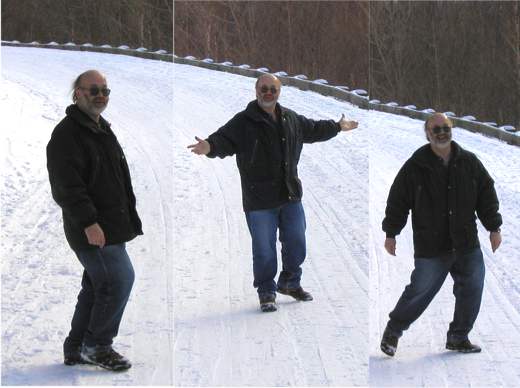
| I must extend my personal thanks
to Jerry. Back in 1998 he helped Ken Merbler and me begin to
understand the Mellotron M400, especially keyboard adjustments. And
all along he's been fielding questions from me (and others for that
matter). Recently he helped me work on a machine, diving in even
more than I did to get it cleaned up and running, including doing all of
the diagnostic work and rescuing the capstan. Meanwhile he and Mali
were gracious hosts for my visit to Vermont, as they always are whenever
anyone drops by. Thanks, Prof! |

Photos: Ken Leonard, Ken Merbler, Jerry Korb
Text: Ken Leonard with contributions from Jerry Korb
Nope, Jerry didn't know this page was being created for him. He thought
he was contributing to the MONEYPIT March 2003 report. :-)
|
